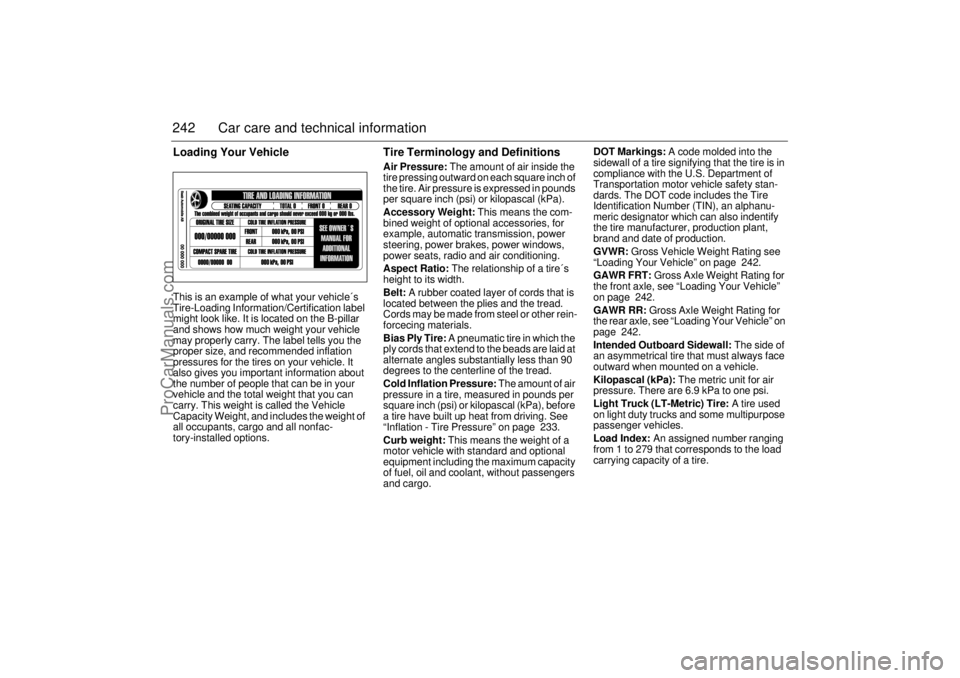window SAAB 9-5 2004 Owner's Guide
[x] Cancel search | Manufacturer: SAAB, Model Year: 2004, Model line: 9-5, Model: SAAB 9-5 2004Pages: 288, PDF Size: 16.91 MB
Page 242 of 288

242 Car care and technical informationLoading Your VehicleThis is an example of what your vehicle´s
Tire-Loading Information/Certification label
might look like. It is located on the B-pillar
and shows how much weight your vehicle
may properly carry. The label tells you the
proper size, and recommended inflation
pressures for the tires on your vehicle. It
also gives you important information about
the number of people that can be in your
vehicle and the total weight that you can
carry. This weight is called the Vehicle
Capacity Weight, and includes the weight of
all occupants, cargo and all nonfac-
tory-installed options.
Tire Terminology and DefinitionsAir Pressure: The amount of air inside the
tire pressing outward on each square inch of
the tire. Air pressure is expressed in pounds
per square inch (psi) or kilopascal (kPa).
Accessory Weight: This means the com-
bined weight of optional accessories, for
example, automatic transmission, power
steering, power brakes, power windows,
power seats, radio and air conditioning.
Aspect Ratio: The relationship of a tire´s
height to its width.
Belt: A rubber coated layer of cords that is
located between the plies and the tread.
Cords may be made from steel or other rein-
forcecing materials.
Bias Ply Tire: A pneumatic tire in which the
ply cords that extend to the beads are laid at
alternate angles substantially less than 90
degrees to the centerline of the tread.
Cold Inflation Pressure: The amount of air
pressure in a tire, measured in pounds per
square inch (psi) or kilopascal (kPa), before
a tire have built up heat from driving. See
“Inflation - Tire Pressure” on page 233.
Curb weight: This means the weight of a
motor vehicle with standard and optional
equipment including the maximum capacity
of fuel, oil and coolant, without passengers
and cargo.DOT Markings: A code molded into the
sidewall of a tire signifying that the tire is in
compliance with the U.S. Department of
Transportation motor vehicle safety stan-
dards. The DOT code includes the Tire
Identification Number (TIN), an alphanu-
meric designator which can also indentify
the tire manufacturer, production plant,
brand and date of production.
GVWR: Gross Vehicle Weight Rating see
“Loading Your Vehicle” on page 242.
GAWR FRT: Gross Axle Weight Rating for
the front axle, see “Loading Your Vehicle”
on page 242.
GAWR RR: Gross Axle Weight Rating for
the rear axle, see “Loading Your Vehicle” on
page 242.
Intended Outboard Sidewall: The side of
an asymmetrical tire that must always face
outward when mounted on a vehicle.
Kilopascal (kPa): The metric unit for air
pressure. There are 6.9 kPa to one psi.
Light Truck (LT-Metric) Tire: A tire used
on light duty trucks and some multipurpose
passenger vehicles.
Load Index: An assigned number ranging
from 1 to 279 that corresponds to the load
carrying capacity of a tire.
ProCarManuals.com
Page 254 of 288

254 Car care and technical informationWashing the carWash your car frequently. To facilitate
cleaning, a suitable detergent can be added
to the water, which should be lukewarm.
Do not use a pressure washer at close
range on stone chip damage, scratches or
other damage to the paintwork. The paint
can otherwise start to flake.
Remove any bird droppings without delay,
as these can discolor the paintwork and
prove difficult to polish out.
Use a soft cloth moistened with methyl alco-
hol to remove splashes of tar or asphalt. Do
not use strong cleaners, as these can dry
out the paintwork.
The underside of the car also needs wash-
ing regularly, and this should be done extra
thoroughly at the end of winter. Clean the
underside of the car by hand if the car is usu-
ally washed in an automatic car wash with-
out special facilities for underbody cleaning.
Never wash or leave the car to dry in the
sun, but wipe it dry with a chamois leather
immediately after washing to avoid smears
and streaks.
Clean the window glass inside and out using
a high quality window cleaner. This is partic-
ularly important when the car is new, as
upholstery and trim have a tendency to
sweat a little at first.
Keep the glass well cleaned, as this helps to
prevent misting.
NOTICEAvoid using any alcohol-based cleaners
on the front and rear light clusters, as
these can cause cracking of the lenses.
NOTICE The door mirrors must be fully
retracted before the car enters an
automatic car wash.
Remove fixed antennas, e.g. for
mobile phone, before putting car
through an automatic car wash.
Try your brakes on leaving a car wash.
Wet brake discs may reduce the per-
formance of the brakes.
Cars with Saab Parking Assistance:
Do not spray the sensors or closer
than 20 cm to the sensors with a pres-
sure washer, as this can damage
them.
ProCarManuals.com
Page 284 of 288

284 IndexDDICE/TWICE
___________________ 228
Dampers
______________________ 277
Date code, tires
_________________ 245
Definitions and terminology, tire
____ 242
Determining correct load, tires
_____ 244
Dim-dipped beam
________________ 69
Direction indicators _______________ 71
Door handles
___________________ 40
Door mirrors
___________________ 121
Doors, locks & luggage compartment
_39
Drive belt
______________________ 275
Drive belt, alternator
_____________ 212
Drive belts, length
_______________ 275
Driver’s seat, programmable
________ 14
Driving at night
_________________ 185
Driving in hot weather
____________ 177
Driving with a load
______________ 185
EEDR
_________________________ 267
ESP __________________________ 172
Electric heating seat
______________ 15
Electric heating, front seats
________ 15
Electric windows
________________ 127
Electrical system, technical data
____ 275
Electronic Stability Program, ESP __ 172
Electronic starting interlock
_________ 41
Emergency operation of sunroof
____ 129
Emission control systems
_________ 202Engine bay
____________________ 201
Engine bay, cleaning
_____________ 255
Engine number
_________________ 280
Engine oil, grade ________________ 273
Engine, description ______________ 203
Engine, technical data ____________ 272
Engine, temperature gauge
________ 61
Engine-oil level, checking
_________ 204
Event Data Recorder
____________ 267
Expansion tank, coolant __________ 207
FFault codes, Audio System
________ 106
Flat spots, tires
_________________ 234
Fluid level, automatic transmission
__ 206
Folding the rear seat, 9-5 Sedan
___ 135
Folding the rear seat, 9-5 Wagon ___ 138
Frequently asked questions on airbag
37
Front fog lights
__________________ 72
Frost warning
___________________ 64
Fuel
__________________________ 154
Fuel consumption
________________ 63
Fuel filler door
__________________ 146
Fuel gauge
_____________________ 61
Fuel grade _____________________ 272
Fuse box under hood
____________ 231
Fuse panel
____________________ 227
Fuses
________________________ 227
GGarage door opener
_____________ 122
Gearbox number
________________ 280
Gearbox oil, checking
____________ 206
Gearbox, technical data, __________ 276
Glove compartment
______________ 132
HHandbrake
_____________________ 196
Hazard warning lights
_____________ 72
Head restraint
___________________ 16
Headlight flasher _________________ 69
Headlights
______________________ 69
Hood
_________________________ 200
Horn __________________________ 120
IIf a tire goes flat
_________________ 239
Ignition switch
__________________ 148
Immobilizer
_____________________ 41
Indicator and warning lights
_________ 54
Indicator lights
___________________ 54
Instrument illumination
____________ 71
Instruments and controls ___________ 53
Interior equipment
_______________ 119
Interior lighting
__________________ 130
Interior rearview mirror
___________ 121
ProCarManuals.com